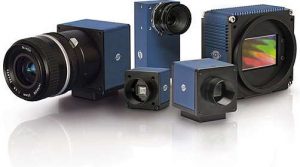Industrial Cameras
Industrial Cameras are a unique generation of cameras that have the most advanced resistance properties of shock and other external forces. When you compare these cameras with other typical modern ones, you will be quick to notice that while industrial cameras can handle up to vibrations and say intense temperatures, standard cameras cannot withstand those forces. It is for this reason that industrial cameras are the most sought-after segments of technology in the 21st century. Consider fields like mining and the pharmaceutical practices.

The art of photography has been part of the history of man and the whole society for far so long, and now technology is taking everything to a whole new level. Today, ethernet cables, high data intensity as well as improvements in quality are some of the core factors to consider when choosing the best cameras. The objective of this study is to bring to light all vital details about industrial cameras and their positive impacts in different schools of life.
The Versatility of Industrial Cameras
Industrial cameras can get the whole task accomplished for you. As it has been made clear in the above section, these cameras have an impressive role to play in the field of medicine. They monitor the health and progress of patients, in business to increase the safety of transactions and sensitive investments in international while in science, it is the epitome of how far technology can affect the lives of everyone in society. In other words, no matter the field of life, industrial cameras always have an influential role to play.
When it comes to professionalism, trust that industrial cameras will do the trick for you. The ideal shooting of high-quality definition images and business is key in distinguishing these cameras from the rest. The most impressive aspect of industrial cameras is that they are unique to their delivery of competent services. In a virtual world, e-ventures understand and embrace the impact of these cameras towards growth and development in society.
Many merits could make you secure one of these for your business. The first advantage is that they have a wide variety of sizes creating the impression that no matter the size of the business, the camera will be certain to accommodate all your needs. Durability is the next benefit. Being able to withstand harsh weather conditions gives the idea that while the rest may malfunction or suffer other technical errors, this generation of cameras does not shiver at the thought of potential hazards.
Software Applications
To prove that the diversity of these cameras stretches far and wide, consider ideas like the heightening use of robotics in advanced scientific experiments and not to forget the testing of non-destructive others of the same perspective. Operating systems and software for processing data are key to considering the compatibility settings of every device before any application. If you are an expert in this field, you can customize your applications according to your level of preferences.
Functions of Industrial Cameras
-
Accuracy
These industrial cameras have a 4 Megapixel resolution and a 400 per second frame speed that will be sure to increase the efficiency of all images and Videos that you can capture. The truth is that accuracy has never been so much on point.
-
Quality
The combination of these two features ensures that even the tiniest bit of a far image will display in this camera. Its ability to focus on all angles of the shot is beyond doubt, and you can tell from the quality of the pics. The better the quality, the higher the value of the camera.
-
Image recording
In these cameras, light spectrum has the power to accommodate a whole lot of high-quality images that can go a long way in saving the firm a lot of resources that when redirected in the right channel, can win the company economies of scale.
Examples of Industrial Cameras
Two major examples which are common in the market are the industrial infrared cameras and the thermal imaging industrial cameras. They perform different roles in industries. The industrial infrared cameras detect any damages in photo-voltaic cells hence improving the conversion of light into electricity. Also, they determine the plastics to go through the recycling process in the recycling industries. The thermal imaging industrial cameras check the temperature of objects. Glass and metal objects require specific temperatures for complete processing hence the thermal cameras monitor for maintenance of the appropriate temperatures.
The Best Sensors
Purchasing industrial cameras requires careful selection of the integrated technology. So far, the two most advanced sensors regarding the cameras are CCD and CMOS. Following reviews from several clients, CCDs and CMOS technology are the best when it comes to the primary requirements of industrial cameras. The devices are effective regarding the dynamic range necessities, nature of the application, wavelengths, and availability of light, frame rate and bit depths. Apart from that, you can find the data from the sensors on the EMVA1288 data sheets.
CCD Guide
CCD means Charged Couple Device. They are among the best sensors of the famous Sony Company are still one of the most preferred sensors on the market due to their high sensitivity. Their main purpose is to capture the images of objects, both moving and still. The devices accomplish the task by seizing light and then converting it into electrons which provide digital information. A great fact about the Charged Couple Devices is their ability to convert light into images without causing distortion.
CMOS Guide
CMOS refers to Complementary Metal Oxide Semiconductor. CMOS is the latest sensory devices for industrial cameras in the market. They are somehow an upgrade from the Charged Couple Devices although they use almost the same mechanism for operation. According to client reviews, CMOS seems to be better than CCDs due to increased sensitivity. Other devices such as smartphones and digital cameras operate using the Complementary Metal Oxide Semiconductors. The devices are also from the Sony Company hence you can be sure that they are of high quality.
The similarity between CCD and CMOS
Charged Couple Devices and Complementary Metal Oxide Semiconductors share one similarity. The start of operation of the two devices is not different, they both convert light photons into electrons for the production of images. Both devices convert light from portions of images into many electrons. In short, they both operate like solar cells at the beginning.
Differences Between CCD and CMOS
The main difference between the two devices is that CCD sensors produce high-quality images than those produced by CMOS. The cause of the distinction is CCD sensors produce images with low noise as compared to CMOS sensors which create images with high noise which means CMOS sensors require a lot of light to produce high-quality pictures with low noise. Hence, Charged Couple Devices are more expensive than Complementary Metal Oxide Semiconductors. However, CMOS is not too less advanced than CCD sensors. They need more exposure to light. They keep advancing in many ways, and many industries are using them just as much as the CCD Sensors.
Verdict
CCD and CMOS sensors are both high-quality devices. Though CMOS produce images with high background noise, you can expose it to more light to get high-quality pictures. Fortunately, the Sony Company keeps improving the CMOS devices to operate as incredible as the CCD sensors. For instance, they are better than CCDs regarding power consumption. CCD chips may also be a perfect choice though they are more expensive than the semiconductors. The two devices are superior to each other in different ways hence purchasing either of them is a smart idea.










